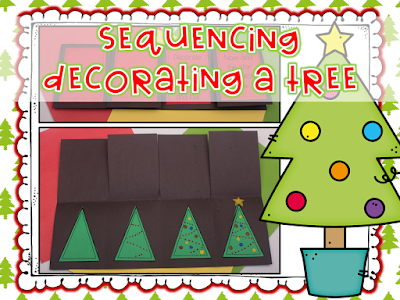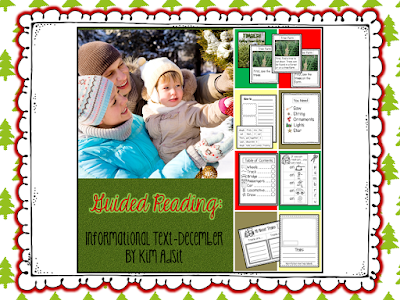At the end of the year we always do a memoir unit in Writer's Workshop. Ask kids the things they remember and you will see the experiences that made a lasting impression. December is a great month to develop memories while tackling lots of standards. Here's the point...we don't have to choose. We don't have to say I can't do "cute", I have to teach the standards. We don't have to say I can't do that anymore, we have standards. The truth is we have ALWAYS had standards. We simply need to reevaluate our activities. We need to be sure that the standard is clear and evident. But, we need to plan fun, engaging, dendrite producing activities.
I love Christmas trees. Over the 32 years of my marriage I have collected so many ornaments that a few years ago I started making "theme" trees. I put a gingerbread tree in the kitchen, Santa tree in the Den, burlap tree in the living room, snowman tree in the office, and a new tree is in the process in the dining room. I always say, "I'm not putting up all those decorations", but something inside me just can't imagine Christmas without them.
I like a Christmas tree in the classroom. It doesn't have to be anything large or take up much room. Just a little sparkle in the corner. All December we make decorations and decorate the tree. The kids love it! I still have some of the decorations Megan and Tyler made when they were tiny. (I actually gave them each their ornaments when they got married.)
Here are a few ways to make trees come "alive" in the classroom.
Here are some cute sequencing pictures of kids decorating a tree. This tackles your sequencing standard.Here each kid makes a lift the flap book to sequence decorating a tree. Art is a dendrite producing activity! Yea for art! On the outside of the flaps, the kids can either write the steps or sequence sentences with the steps. This helps you with your informational text and informational writing standards. We can't ask kids to produce informational text or to understand the text they read if we have not provided the schema necessary to be successful.
I love this ornament number line game. To make the game:
- Make a deck of cards with 4 different ornaments.
- Make one card with only the ornament and more cards with the numerals 1-10.
- Place the 4 ornaments without a number face up in a vertical line.
- Shuffle the remaining 40 cards and lay them face down in an array.
- Invite a child to turn over a card, like the Star 7 above.
- They must decide where it belongs on the number line.
- They pick up the card in that space (the number 5 candy cane) and replace it with the number 7 star.
- Then, they put the number 5 candy cane in its correct space.
- Continue until all 4 number lines are made.
This is a fun little interactive chart. It is sung to the tune of "The Wheels on the Bus." What do interactive charts and songs teach?
- The kids can practice all of their print concepts, left to right, top to bottom, and one to one.
- They can also look for sight words, punctuation, and capital letters.
- Songs are a great way to develop fluency in reading. Songs develop prosody, the natural rhythm of good reading.
- The children each made a tree for their poetry journal. They cut and sequenced the triangles by size, a great measurement standard activity.
- They put the poem in their poetry journal. They keep their poetry journal in their bag of books for repeated reading--another way to develop prosody.
- Cut out a tree shape in a piece of scrapbooking paper.
- Cut holes in a green piece of paper and glue it to the back of the scrapbooking paper.
- Glue the words on another piece of scrapbooking paper.
- Laminate.
- Tape the pocket together along the sides leaving the top open.
- Slide pieces of construction paper inside the pocket.
- The colored paper will show through the holes in the green paper.
- Pull the paper out as you sing the song.
I had a teacher tell me the best way to remember the difference between phonics and phonemic awareness. She said, "Phonemic Awareness can be done in the dark." Exactly, phonemic awareness only deals with the sounds, not the letter symbols. In this activity, the kids were practicing their phonemic skills of segmenting phonemes. For each sound, they slid a light up onto the Christmas tree. Later, the children practiced their phonics skills by selecting pictures and writing letters to represent the 3 sounds they hear.
To make this story problem tree, here's what we did.
- We invited the kids to cut a triangle tree.
- Then, they roll a dice to create an equation.
- Next, they glued ornaments to match the number sentence.
- Invite the kids to write or dictate a story problem to match the equation. This is a great way to solve an abstract problem conceptually!
- After reading lots of informational text about evergreen trees, the children created a bubble map where they wrote describing words about trees.
- Later, the children created a table of contents by selecting 4 of their describing words.
- Then, we stapled the table of contents into a booklet where they children drew, wrote, dictated informational text about evergreens.
- The children worked in partners, with each partner creating their own tree.
- Then, each child made a list of the things on their Christmas tree.
- Now they are ready to work in partners.
- The children took turns reading the things that were on their list.
- As they read, they decided where to place that items on the Venn Diagram. Was it just on their tree, or was it on their partners tree, too.
All of these activities are from this Christmas Tree Unit.
To help us with learning more factual information through a procedural piece, I wrote a nonfiction book "Timber: Cutting Down a Tree." In this book, the kids learned all about procedural text. - They learned to look for sequencing words like first, next, and last.
- They learned why you need a you need list.
- They learned to look for headings to let you know the main idea on each page.
Then, we used our text to sequence cutting down the tree. I don't want the kids to just memorize, I want them to go back to the text to check. They also added headings. We also sorting pictures by beginning sounds--st or tr. For our word work we made _ing words!




















































































